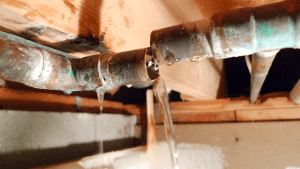Just how to Examine If Your Residence Has a Concealed Leak
Just how to Examine If Your Residence Has a Concealed Leak
Blog Article
What're your insights and beliefs on Detecting hidden plumbing leaks?
.jpg)
Early detection of dripping water lines can alleviate a prospective disaster. Some little water leaks may not be visible.
1. Take A Look At the Water Meter
Every residence has a water meter. Checking it is a surefire way that assists you find leakages. For beginners, shut off all the water resources. Make sure no person will purge, use the tap, shower, run the cleaning maker or dish washer. From there, go to the meter and watch if it will certainly change. Because no person is using it, there need to be no activities. If it relocates, that shows a fast-moving leakage. If you spot no adjustments, wait an hour or two and also check back again. This indicates you might have a slow-moving leak that might even be below ground.
2. Examine Water Intake
If you find abrupt adjustments, in spite of your consumption being the same, it means that you have leakages in your plumbing system. An abrupt spike in your costs shows a fast-moving leakage.
A steady increase every month, also with the very same behaviors, reveals you have a slow leakage that's likewise slowly intensifying. Call a plumber to extensively inspect your property, especially if you really feel a cozy location on your floor with piping underneath.
3. Do a Food Coloring Examination
30% comes from commodes when it comes to water usage. Examination to see if they are running appropriately. Decrease flecks of food shade in the tank and also wait 10 minutes. There's a leakage between the container and dish if the color somehow infiltrates your dish during that time without flushing.
4. Asses Outside Lines
Don't fail to remember to check your outdoor water lines as well. Examination spigots by affixing a garden hose pipe. Needs to water seep out of the connection, you have a loosened rubber gasket. Replace this as well as make certain all connections are tight. If you have actually got a sprinkler system, it will assist get it professionally analyzed and also maintained yearly. One small leakage can throw away lots of water and spike your water bill.
5. Inspect and Analyze the Circumstance
Home owners must make it a practice to examine under the sink counters and also also inside cupboards for any type of bad odor or mold and mildew development. These two red flags indicate a leak so prompt attention is needed. Doing routine evaluations, even bi-annually, can save you from a significant trouble.
Examine for discolorations as well as damaging as many devices as well as pipelines have a life expectations. If you suspect leaking water lines in your plumbing system, don't wait for it to rise.
Early detection of leaking water lines can reduce a prospective disaster. Some tiny water leakages may not be visible. Checking it is a guaranteed method that helps you discover leakages. One small leak can lose heaps of water and increase your water expense.
If you suspect leaking water lines in your plumbing system, do not wait for it to escalate.
How to Know If Your Home Has a Hidden Leak
Water Meter Reveals Inexplicable Water Usage
If you’d like to test whether or not there’s a leak somewhere in your home, you can do this using your water meter. Here is how to conduct the test:
Don’t use any water in your home for at least 30 minutes; this also means not turning on faucets or water-using appliances.
Go outside, and check your water meter for activity.
If your water meter shows that there was activity, even though no one was using any water, this proves that there is a leak in your home.Visible Mold or Mildew Growth
Leaks behind walls create moist, dark environments that allow mold and mildew to grow and thrive. Eventually, you might see mold growth forming on the wall closest to a hidden leak.
If mold is growing in an area that receives a high amount of moisture, such as a bathroom, it may simply be an indication that better ventilation is needed. However, if you see mold growth on a wall or the ceiling in an area where you would not expect, you probably have a hidden leak.
Musty, Mildew Odor
Sometimes you might not be able to see the mold or mildew that is growing as a result of a leak. However, the smell can give the problem away just as easily. If you catch a whiff of something musty, there’s a good chance that old water is collecting somewhere in your home that you can’t see.
Stained/Warped Walls, Ceilings, or Floors
When your home soaks up water, a variety of red flags can become visible, including ceiling stains, bubbling drywall, warped walls, and sagging floors. While these issues can be caused by excess humidity, they can also be signs that a pipe or plumbing connection has started leaking behind your walls.
Inexplicably High Water Bill
After a while, you get a general sense for what your water bill should be. If you own a pool or sprinkler system, your bill will tend to be higher during summer. However, if you receive a water bill that seems especially high, and you can’t figure out what caused it, then you may have a hidden leak somewhere that’s increasing your bill.
https://www.plumbingjoint.com/blog/2019/july/how-to-know-if-your-home-has-a-hidden-leak/

I hope you enjoyed reading our part on Finding hidden leaks. Thank you so much for taking time to browse our posting. If you appreciated our article kindly do not forget to pass it around. Thanks for your time invested reading it.
Report this page